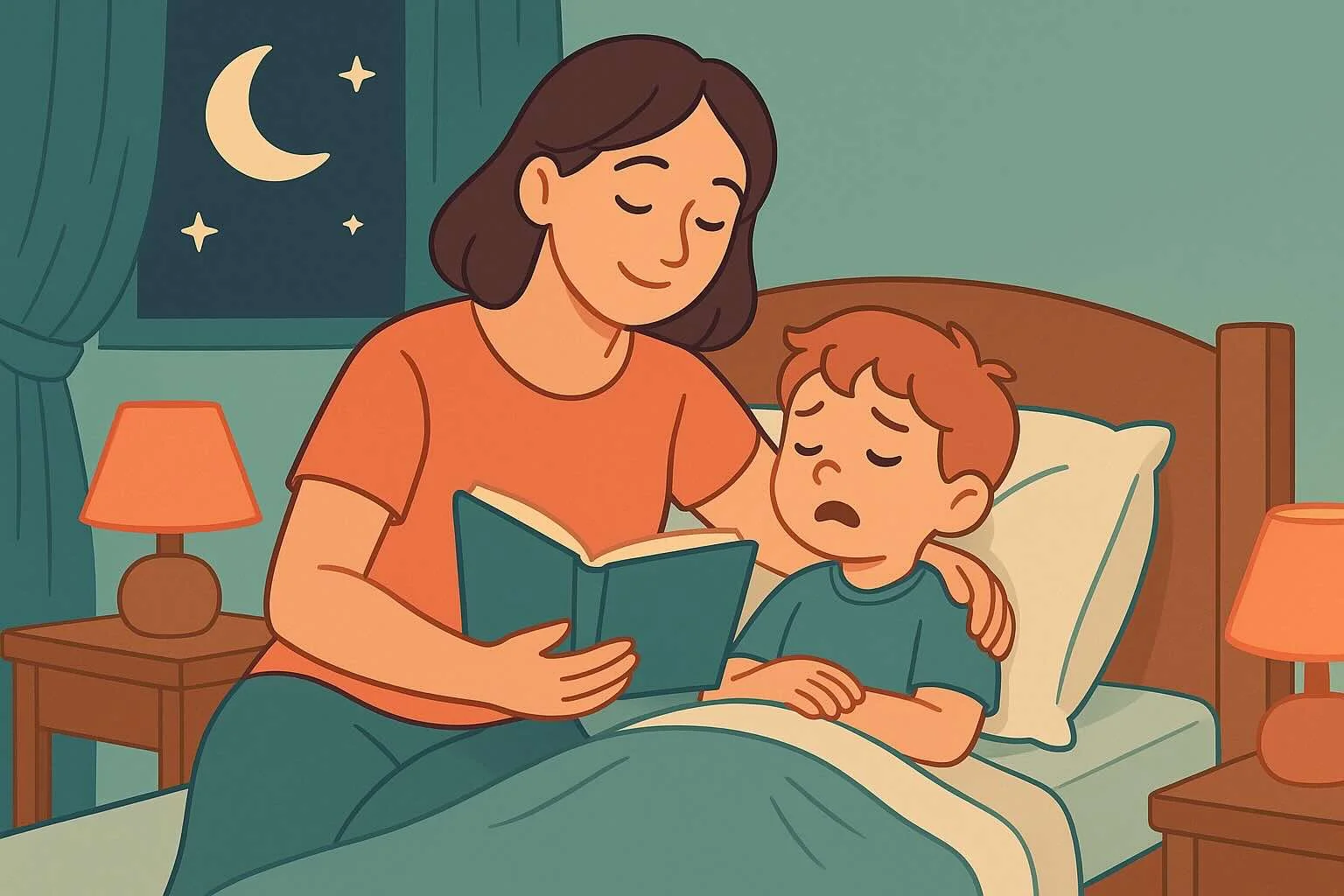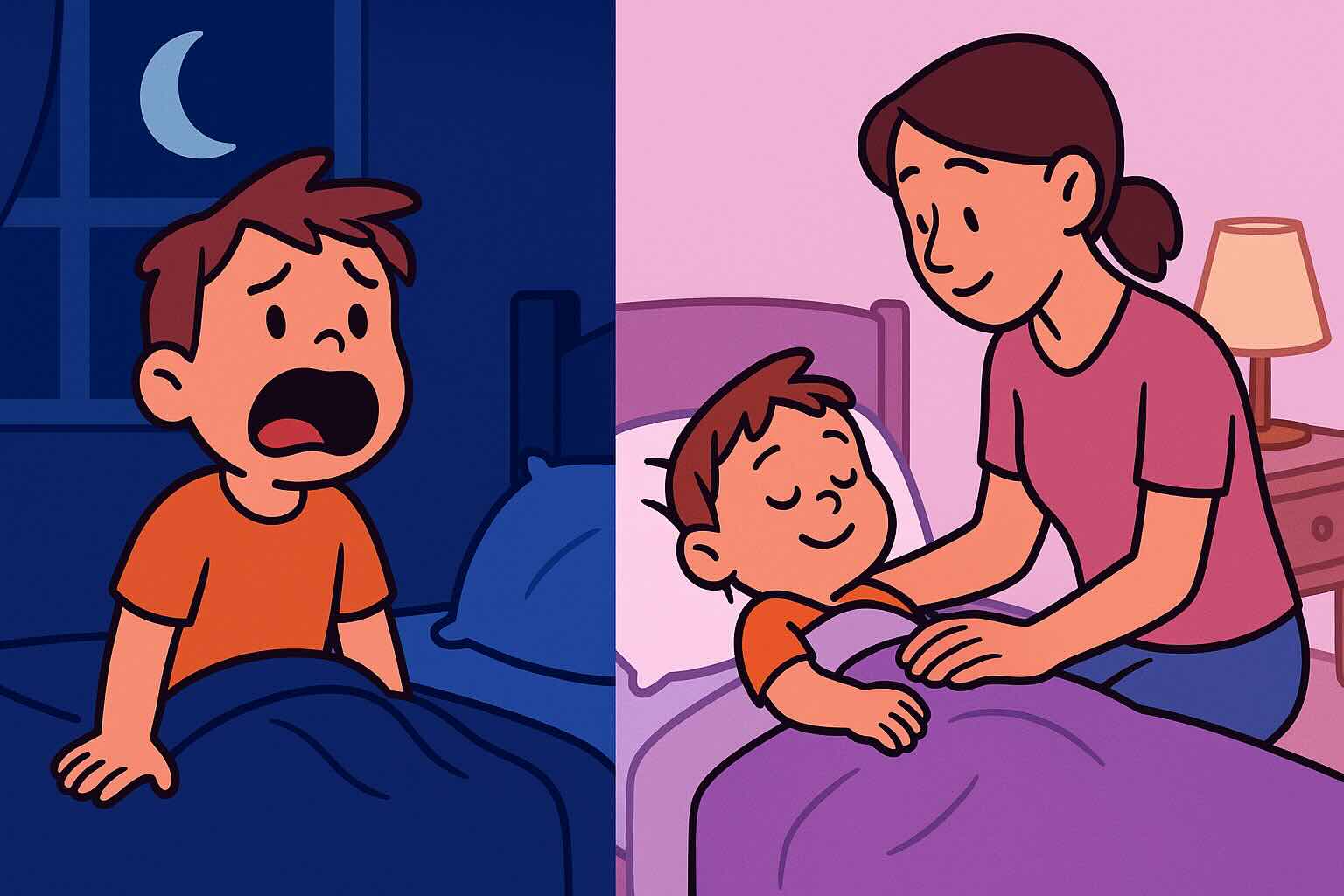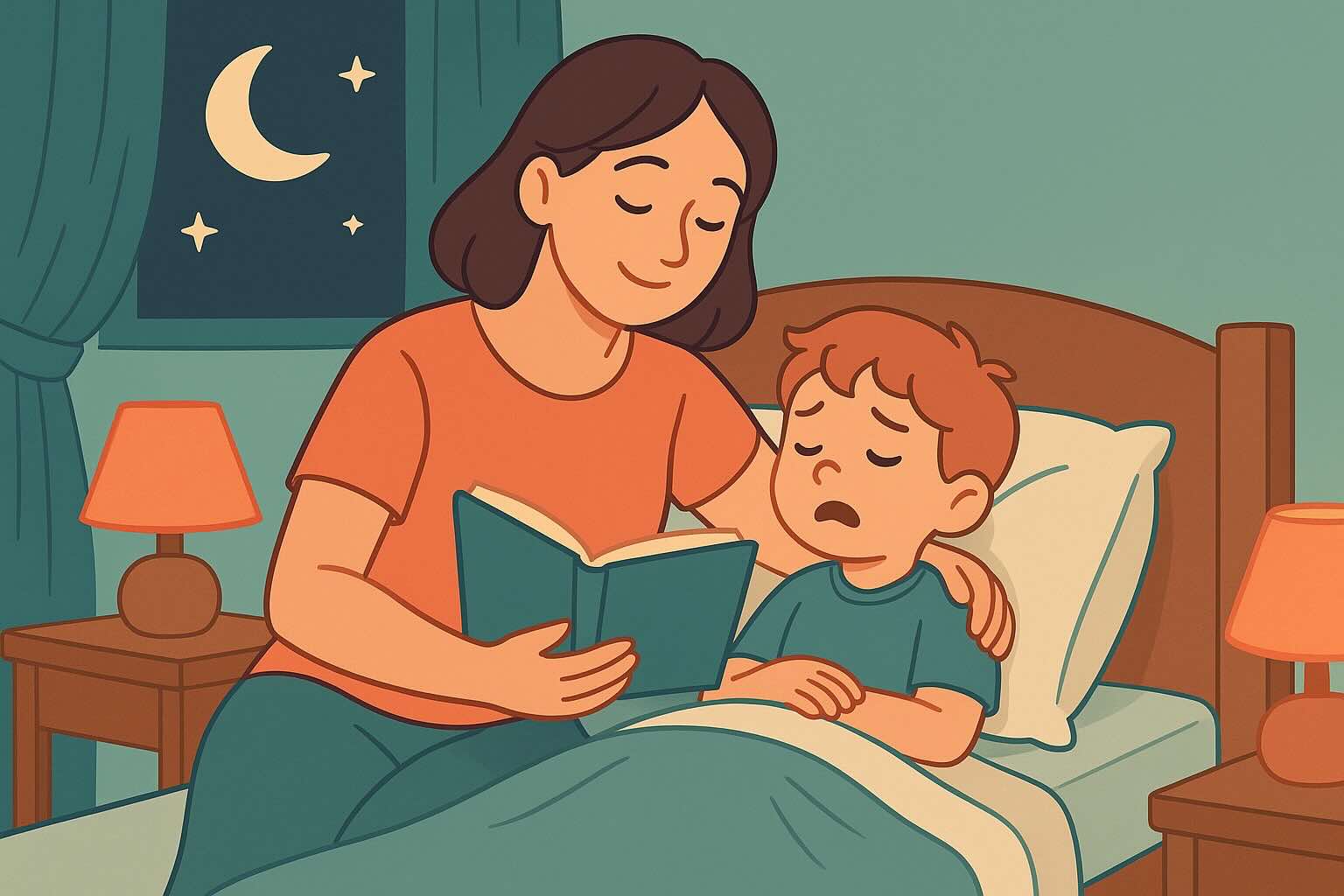Bedtime Fears and Anxiety: 9 Strategies for Peaceful Nights

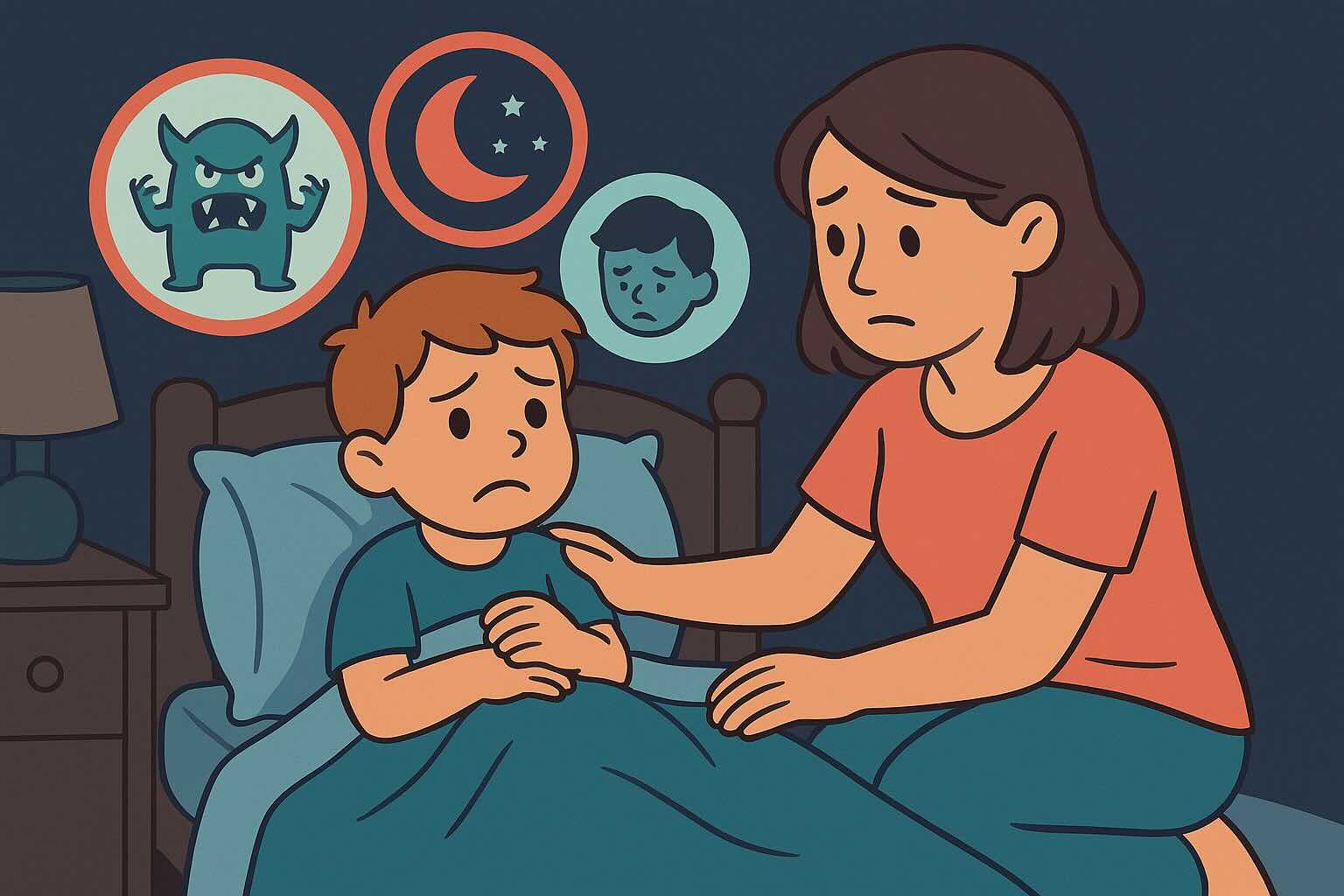
If your evenings are consumed by checking under beds, leaving doors open, and negotiating with an increasingly anxious child about imaginary threats, you're witnessing one of childhood's most common developmental phases. Research shows that 73% of children ages 3-7 experience significant bedtime fears, but here's what many parents don't know: trying to logic away fears often makes them stronger.
This comprehensive guide provides evidence-based strategies to help your child develop genuine courage and independent coping skills. Instead of endless reassurance that teaches dependence, you'll learn how to validate their emotions while building their internal strength to face fears confidently.
What You'll Learn in This Guide
- Why Bedtime Fears Peak at Ages 3-7 - The developmental science behind fear emergence
- The Fear vs. Danger Distinction - How children's brains process real vs. imaginary threats
- The Courage-Building Method - A 4-step approach that develops internal coping skills
- Common Fear Categories - Specific strategies for monsters, darkness, separation, and worry thoughts
- What NOT to Do - Common responses that accidentally strengthen fears
- Environmental Solutions - How to create security without reinforcing anxiety
- Long-Term Fear Prevention - Building resilience for future challenges
For comprehensive sleep support, also explore our guides on ending bedtime battles, establishing healthy sleep habits, reducing night wakings, and transitioning to independent sleep. For additional support with nighttime fears, our complete nighttime fears guide provides the CALM method and age-specific strategies for building courage. If bedtime fears are accompanied by intense tantrums, our night tantrums guide addresses the emotional meltdowns that often occur alongside fear-based resistance. For children with anxiety that extends beyond bedtime, our childhood anxiety complete guide provides broader anxiety management strategies.
Estimated reading time: 11 minutes
The Developmental Science of Bedtime Fears
Why Ages 3-7 Are Peak Fear Years
Cognitive Development and Fear Emergence: Between ages 3-7, children experience rapid cognitive growth that creates the perfect storm for fear development:
- Vivid imagination explosion allows them to create detailed mental scenarios
- Limited reality testing means they can't reliably distinguish fantasy from reality
- Cause-and-effect understanding develops faster than risk assessment abilities
- Awareness of danger emerges without sophisticated reasoning skills to evaluate actual risk
Evolutionary Perspective: Childhood fears served an important survival function throughout human evolution. Children who were naturally cautious about darkness, strange noises, and separation from caregivers were more likely to survive. These ancient protective mechanisms are still active in modern children's brains.
Normal Fear Development Patterns
Ages 3-4: Concrete Fears
- Monsters, ghosts, "bad guys"
- Animals and insects
- Loud noises and sirens
- Being alone or separated from parents
Ages 5-7: Abstract Worries
- Death and injury concerns
- Natural disasters and emergencies
- Kidnappers and strangers
- School performance and social fears
When Fears Are Developmentally Appropriate:
- Don't significantly interfere with daily activities
- Respond to comfort and coping strategies
- Gradually improve with support and time
- Are proportionate to the child's exposure to concerning information
Normal vs. Concerning Fear Patterns
Typical bedtime fears include:
- Asking for doors to stay open or lights on
- Wanting comfort objects or extra hugs
- Expressing worry about imaginary threats
- Taking 10-20 minutes longer to fall asleep when fears are active
- Seeking reassurance about family safety
For children whose bedtime fears manifest as sleep-related nightmares or frequent night wakings, our nighttime fears complete guide provides specialized strategies for ongoing fear-related sleep disruptions.
Professional consultation warranted for:
- Fears persisting beyond age 7-8 without improvement
- Physical symptoms like panic attacks, vomiting, or extreme distress
- Complete inability to sleep alone for weeks despite support
- Fears that significantly impact school, friendships, or family functioning
- Regression in other developmental areas due to fear-related stress
The Courage-Building Method: A 4-Step Framework
This approach focuses on developing your child's internal coping abilities rather than providing external reassurance that teaches dependence on others for comfort.
Step 1: Validate the Feeling, Not the Fear
The difference between validation and reinforcement:
Validation (builds coping): "I can see you're feeling worried about bedtime."
Reinforcement (strengthens fear): "Let's check under the bed to make sure there are no monsters."
Validation scripts that work:
- "Your mind is having worry thoughts about bedtime."
- "I understand that feels scary to you."
- "Your body is telling you that you feel unsafe right now."
- "It makes sense that darkness feels different than daytime."
What to avoid:
- "Don't be scared" (dismisses their experience)
- "There's nothing to be afraid of" (invalidates their perception)
- "You're being silly" (shames natural emotions)
- "I'll prove there are no monsters" (reinforces the need for external validation)
Step 2: Distinguish Between Feeling and Reality
Help your child understand that feelings are real and valid, but they don't always reflect current reality.
For imaginary fears (monsters, ghosts): "Your worry about monsters feels very real in your mind AND monsters are imaginary. Both of those things can be true at the same time."
For real-world concerns (robbers, fires): "Sometimes our minds worry about things that could happen AND right now you are safe. We have locks on our doors and smoke detectors to keep us safe."
For children whose fear-based resistance escalates into intense emotional outbursts, combining these fear management strategies with our night tantrums bedtime guide can address both the underlying fears and the behavioral meltdowns that often accompany them.
Teaching the feeling vs. reality distinction:
- "Your mind is very good at imagining things. That's actually a superpower!"
- "Sometimes our imagination creates scary pictures, and sometimes it creates happy pictures."
- "You get to choose what pictures you want your mind to make."
Step 3: Build Internal Coping Powers
Instead of providing external comfort that your child becomes dependent on, teach them skills they can use independently.
Imagination redirection (for ages 3-7): "Since your imagination is so powerful, let's use it to help you feel safe. What if you imagined you had invisible armor that protected you? What would it look like?"
Reality grounding (for ages 5-7): "Let's use our detective skills. Look around your room. What do you see that shows you're safe right now? Your bed, your stuffed animals, the light in the hallway..."
Body-based coping (all ages):
- Deep breathing: "Breathe in like you're smelling a flower, breathe out like you're blowing out a candle"
- Progressive relaxation: "Squeeze your muscles tight, then let them go floppy like spaghetti"
- Grounding: "Feel your body in your soft bed, hear the sounds of home around you"
Step 4: Practice During Calm Moments
Daytime fear preparation: During relaxed times, practice coping skills without the pressure of actual fear:
- Role-play bedtime scenarios with dolls or stuffed animals
- Read books about characters who overcome fears
- Practice breathing exercises during car rides
- Discuss how brave people feel scared AND do brave things anyway
Building the "courage muscle": "Being brave doesn't mean you never feel scared. Being brave means you feel scared AND you do what you need to do anyway. Let's practice being brave."
Addressing Specific Fear Categories
Monster and "Bad Guy" Fears
Understanding the fear: Children this age are learning about good vs. evil and safety vs. danger. Monsters represent their attempt to understand and categorize threats.
Effective responses:
- "Monsters are imaginary characters from stories and movies. They're not real."
- "Your mind is so creative that it can make monsters feel real even though they're pretend."
- "What would you like to imagine instead? A friendly dragon? A magical unicorn?"
Ineffective responses to avoid:
- Monster spray, dream catchers, or elaborate protection rituals
- Checking under beds or in closets
- Detailed explanations about why monsters don't exist
- Negotiating about monster-related requests
Empowerment strategies:
- "You are the boss of your imagination. What do you want it to create?"
- "If a worry monster visits your thoughts, you can tell it: 'You're just pretend. Time to go away.'"
- "What would a brave superhero do if they had worry thoughts?"
Fear of Darkness
Understanding the fear: Darkness represents the unknown and triggers ancient survival instincts about potential hidden dangers.
Practical solutions:
- Small nightlight that provides security without disrupting sleep
- Gradual darkness adaptation during daytime (closets, bathroom with door partially closed)
- "Darkness detective" games during day to explore shadows
Coping skill development: "In the dark, your other senses become super strong. Let's practice using your super hearing. What sounds tell you that you're safe at home?"
Avoid:
- Bright lights that interfere with natural sleep cycles
- Promising to keep lights on "forever"
- Checking "dark places" to prove safety
Separation Anxiety at Bedtime
Understanding the fear: Bedtime represents temporary separation, which can trigger attachment anxiety and fear of abandonment.
Gradual independence building:
- Week 1: Sit next to bed during entire routine
- Week 2: Sit in doorway for final few minutes
- Week 3: Stand in doorway briefly, then leave
- Week 4: Brief goodnight from doorway
Connection maintenance strategies:
- "I'll be [specific location] doing [specific activity]. You can think about me there."
- "Every few minutes, I'll think about you in your cozy bed. You can think about me too."
- Comfort object that "holds your love" when you're not there
Scheduled check-ins: "I'll check on you in 10 minutes to see how you're doing. Your job is to practice lying quietly and thinking peaceful thoughts."
Worry Thoughts and "What If" Spirals
Understanding the pattern: School-age children develop abstract thinking, leading to "what if" scenarios that can spiral into anxiety.
Thought management techniques:
- "Worry thoughts are like clouds—they come and go. You don't have to hold onto them."
- "We can have worry thoughts visit our minds without inviting them to stay for dinner."
- "What's something wonderful you could think about instead?"
Worry time boundaries: "Bedtime is for rest thoughts, not worry thoughts. We can worry about that tomorrow during worry time if you still want to."
Problem-solving for realistic concerns: "If you're worried about [real issue], let's make a plan tomorrow. Right now is for sleeping."
Environmental Solutions That Help
Creating Security Without Reinforcing Fear
Helpful environmental modifications:
- Consistent, predictable bedtime routine
- Comfort objects (stuffed animals, special blanket)
- Small nightlight positioned to minimize shadows
- Door positioned consistently (cracked open same amount each night)
- White noise or soft music to mask concerning sounds
Modifications to avoid:
- Elaborate checking rituals
- "Monster spray" or other magical protection items
- Promises to check on them frequently throughout the night
- Allowing lights bright enough to interfere with sleep
- Removing all darkness gradually (this prevents adaptation)
The Role of Comfort Objects
Why they work: Comfort objects provide security and sensory grounding while teaching self-soothing skills.
Effective use:
- Let your child choose their comfort object
- Practice "charging" the object with love during daytime
- Use it consistently, not just when fears are high
- Gradually reduce dependence as child develops other coping skills
What NOT to Do: Common Mistakes That Strengthen Fears
Providing Excessive Reassurance
Why it backfires: Constant reassurance teaches children they can't trust their own assessment of safety and need external validation to feel secure.
Instead of: "I promise there are no monsters. Let me check under the bed." Try: "You're worried about monsters AND you are safe. What could you tell yourself to feel braver?"
Logic-Heavy Explanations During Fear States
Why it doesn't work: When children are experiencing fear, their emotional brain is activated and logic-processing abilities are reduced.
Instead of: Extended explanations about why fears are irrational Try: Brief validation followed by coping skill practice
Making Promises You Can't Keep
Avoid: "Nothing bad will ever happen" or "I'll never leave you" Try: "You are safe right now" and "I will always take care of you"
Creating Elaborate Protection Rituals
Why they backfire: Rituals reinforce the idea that there's actually something to be protected from.
Instead of: Monster spray, checking routines, special protection procedures Try: Building internal coping skills and confidence
Age-Specific Strategies
Ages 3-4: Concrete Thinking Stage
Developmental characteristics:
- Magical thinking is prominent
- Difficulty distinguishing fantasy from reality
- Need for sensory comfort and presence
- Learning through repetition and routine
Effective approaches:
- Simple, concrete language
- Heavy use of comfort objects and physical presence
- Imagination redirection to positive images
- Consistent routines that build security
Sample scripts:
- "Your teddy bear is very brave and will stay with you all night."
- "Let's think about happy things like puppies and rainbows."
- "Mommy and Daddy are nearby keeping you safe."
Ages 5-7: Emerging Logic Stage
Developmental characteristics:
- Beginning to understand cause and effect
- Can engage in simple problem-solving
- Developing self-talk abilities
- More aware of real-world dangers
Effective approaches:
- Teach simple reasoning skills
- Encourage self-talk and affirmations
- Practice coping strategies during calm moments
- Address real vs. imaginary distinctions
Sample scripts:
- "What could you tell yourself if worry thoughts visit?"
- "Let's think like scientists: what evidence shows you're safe?"
- "You're learning to be the boss of your own thoughts."
Building Long-Term Resilience
The Courage Development Process
Understanding courage: Courage isn't the absence of fear—it's feeling fear and choosing to act in spite of it.
Progressive courage building:
- Acknowledge fear: "I notice I'm feeling scared"
- Assess reality: "Am I actually in danger right now?"
- Choose coping: "What can I do to help myself?"
- Take action: "I can be scared and still [go to bed/stay in my room/try again]"
Preventing Future Fear Escalation
Media exposure management:
- Monitor and limit exposure to scary content
- Discuss disturbing images or stories your child encounters
- Prepare for and process potentially frightening experiences
Building general confidence:
- Encourage age-appropriate independence
- Celebrate small acts of bravery
- Teach general problem-solving skills
- Model healthy emotional regulation
Teaching Fear as Information
Help children understand: Fear is their brain's way of trying to keep them safe, but sometimes it makes mistakes about what's actually dangerous.
"Your brain is like a very careful bodyguard. Sometimes it warns you about real dangers, and sometimes it warns you about imaginary dangers. You can listen to the warning and then decide what's really happening."
Realistic Timeline for Fear Resolution
Week 1-2: Learning and Resistance
Expect: Initial increase in fear expression as child tests whether new approach will stick. They may escalate behaviors to get old comfort responses.
Your focus: Consistent application of validation + coping skill building. Don't revert to old reassurance patterns.
Week 3-4: Gradual Improvement
Expect: Beginning signs of independent coping. Child may still ask for help but shows some willingness to try skills themselves.
Your focus: Celebrate any attempts at brave behavior, even if unsuccessful. Continue building skills during calm moments.
Week 5-8: Integration and Confidence
Expect: More consistent use of coping skills. Fears may still surface but with less intensity and shorter duration.
Your focus: Reinforce independence while remaining available for support. Prepare for regression during stress.
Beyond 2 Months: Maintenance
Expect: Occasional fear recurrence during illness, life changes, or exposure to scary content, but faster recovery with established skills.
Your focus: Continue reinforcing coping skills and maintain supportive environment.
Professional Help: When and What Type
Indicators for Professional Support
Consider consultation if:
- Fears persist beyond age 7-8 without improvement
- Physical symptoms accompany fears (panic attacks, vomiting, severe distress)
- Sleep is significantly impacted for more than 4-6 weeks
- Fears generalize to daytime activities or school
- Family functioning is severely affected
- Child shows signs of depression or withdrawal related to fears
Types of Professional Support
Child psychologists specializing in anxiety can provide:
- Cognitive-behavioral therapy adapted for children
- Play therapy for younger children
- Family therapy to address interaction patterns
- Assessment for anxiety disorders
Pediatricians can:
- Rule out medical causes of sleep difficulties
- Provide referrals to mental health specialists
- Assess overall development and wellbeing
Real Parent Success Stories
Anna's Story: Monster Fears at Age 4
"My daughter Maya was convinced monsters lived in her closet. I was checking the closet every night and it was getting worse. I learned to stop checking and instead taught her to use her 'brave voice' to tell worry thoughts to go away. I gave her a special stuffed dog to be her 'brave buddy.' It took about 3 weeks, but she started sleeping through the night and even told me she didn't need me to check anymore."
James's Story: Separation Anxiety at Age 6
"My son couldn't sleep unless I was in his room. We gradually moved my chair farther from his bed each week. I also started leaving a worn t-shirt that smelled like me on his nightstand. The shirt helped him feel connected even when I wasn't there. After about 6 weeks, he was sleeping independently and felt proud of his bravery."
Lisa's Story: Worry Thoughts at Age 7
"My daughter started having 'what if' spirals about house fires and burglars. Instead of explaining all our safety measures repeatedly, I taught her to notice when her brain was 'visiting worry land' and redirect to 'peaceful land.' We practiced during the day with her imagining safe, happy places. She learned to catch worry thoughts early and switch them herself."
Your 4-Week Fear-Busting Plan
Week 1: Assessment and Foundation
- Observe and document specific fears and current responses
- Begin validation + reality distinction conversations
- Introduce basic coping skills during calm moments
- Eliminate checking or reassurance-seeking accommodations
Week 2: Skill Building and Practice
- Practice coping skills daily during non-fear times
- Begin gradual independence building if applicable
- Introduce comfort objects or environmental modifications
- Maintain consistent responses to fear expressions
Week 3: Confidence Building
- Celebrate any brave behaviors, however small
- Encourage child to coach themselves through fears
- Reduce adult involvement in fear management
- Address any remaining environmental concerns
Week 4: Independence and Mastery
- Support child in using skills independently
- Plan for future challenges and setbacks
- Establish maintenance routines
- Evaluate progress and adjust strategies if needed
Key Takeaways: Building Brave Bedtimes
- ✅ Bedtime fears are developmentally normal and affect 73% of children ages 3-7
- ✅ Validation without reinforcement builds genuine coping skills
- ✅ Internal courage development is more effective than external reassurance
- ✅ Gradual skill building works better than sudden independence demands
- ✅ Environmental support can help without reinforcing fear
- ✅ Age-appropriate strategies match developmental capabilities
- ✅ Consistency and patience lead to lasting improvement
- ✅ Professional help is available for persistent or severe fears
Remember: Every time you help your child face their fears with courage rather than avoidance, you're building resilience that will serve them throughout life. You're not just helping them sleep—you're teaching them that they have the power to cope with challenges.
If bedtime fears are contributing to frequent night wakings, our night wakings solutions guide provides strategies for helping children return to sleep independently after brief awakenings. For evidence-based information about sleep training approaches when fears are present, our sleep training guide addresses safety considerations and realistic expectations.
This article is based on current research in developmental psychology and pediatric anxiety treatment. Individual children may need personalized approaches based on temperament and specific circumstances. Consult with qualified professionals if fears significantly impact daily functioning or family wellbeing.
24/7 AI Parenting Assistant
Get instant, personalized advice with expert-curated parenting knowledge. Chat with your AI coach anytime, anywhere.
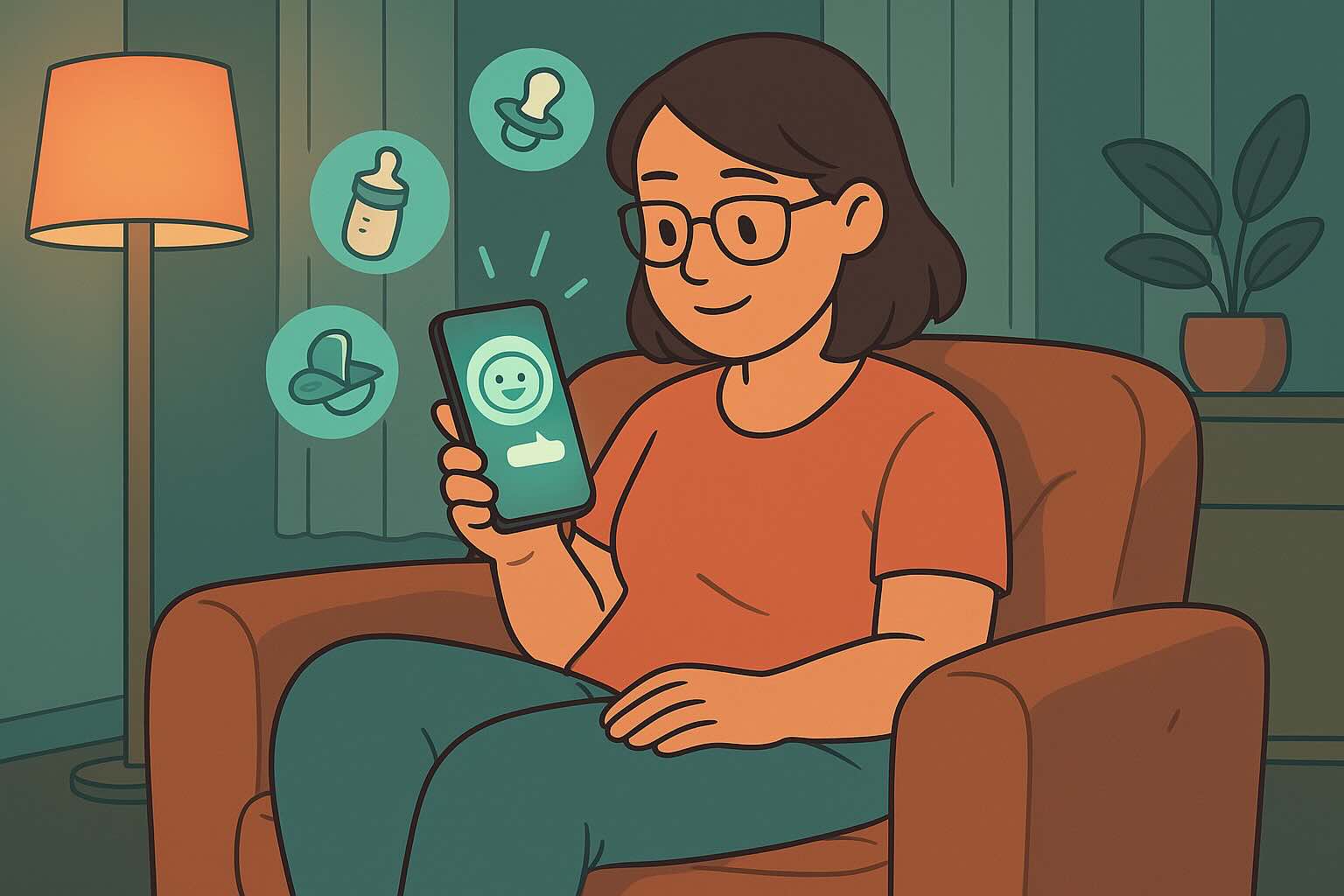
Get Your Free Sleep Training Toolkit
5-day email course + printable sleep log to help your baby sleep through the night
Frequently Asked Questions
Need personalized support?
RootWise's AI coach can provide tailored strategies for your specific situation, available 24/7 when you need it most.
Learn More About AI Coaching →